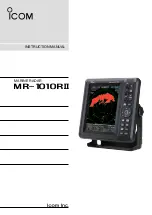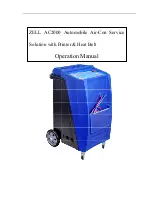
Page
171
of
254
Version 6.3
Rev
r012
Date
05-11-2022
11.8
Improving the Patch Test and Patch Test results
Section 11.7 described areas that should be addressed to improve the results of the patch
test when collecting the data. Further improvement will come with the number of data
collections and the manner in which the patch test is computed.
11.8.1
Need to collect sufficient data
Too many times, surveyors will collect just a few lines of data for each test. One of the major
issues, detailed above, is the variability of the position accuracy of DGPS. Another issue,
detailed above, is the steering of the vessel during the data collection and the relationship of
the sonar head to the feature or slope on each data collection.
To overcome the variability of the DGPS positioning and vessel steering, it follows that the
more tests that are performed, the greater will be the reliability of the test results. Below, is
an example of a multibeam calibration, which included five data collections for each test.
ROLL
PITCH
YAW
0.73
-0.73
1.02
0.73
-0.99
0.90
0.76
-2.16
0.81
0.76
-1.07
2.26
0.74
-0.83
0.94
Pitch mean with erroneous value = -1.16 (SD = 0.58); without erroneous value of -2.16 = -0.91 (SD = 0.13) Yaw
mean with erroneous value = 1.19 (SD = 0.61); without erroneous value of 2.26 = 0.92 (SD = 0.08)
Consider the above patch test and what the result would have been if only two collections
were made and those were the ones that contained the highlighted values, which can
clearly be seen to be outside of the trend. Having more data to work with will create a more
reliable result.
The more data collected, the more evident will be any out of trend values that may reflect a
DGPS wobble, a steering issue, or variability of the positioning of the pole. Enough data
should be collected to provide a reliable statistical result, i.e. mean and standard deviation.
Collecting enough data to compute six of each test, allows the exclusion of any one ‘out of
trend’ result to yield a mean and standard deviation derived from five computations; this
would be a statistically viable sampling.
Summary of Contents for 2026
Page 2: ...Page 2 of 254 Version 6 3 Rev r012 Date 05 11 2022 Part No 96000001...
Page 14: ...Page 14 of 254 Version 6 3 Rev r012 Date 05 11 2022 Part No 96000001...
Page 22: ...Page 22 of 254 Version 6 3 Rev r012 Date 05 11 2022 Part No 96000001...
Page 28: ...Page 28 of 254 Version 6 3 Rev r012 Date 05 11 2022 Part No 96000001...
Page 32: ...Page 32 of 254 Version 6 3 Rev r012 Date 05 11 2022 Part No 96000001...
Page 48: ...Page 48 of 254 Version 6 3 Rev r012 Date 05 11 2022 Part No 96000001...
Page 56: ...Page 56 of 254 Version 6 3 Rev r012 Date 05 11 2022 Part No 96000001...
Page 116: ...Page 116 of 254 Version 6 3 Rev r012 Date 05 11 2022 Part No 96000001...
Page 120: ...Page 120 of 254 Version 6 3 Rev r012 Date 05 11 2022 Part No 96000001...
Page 122: ...Page 122 of 254 Version 6 3 Rev r012 Date 05 11 2022 Part No 96000001...
Page 131: ...Page 131 of 254 Version 6 3 Rev r012 Date 05 11 2022...
Page 138: ...Page 138 of 254 Version 6 3 Rev r012 Date 05 11 2022 Part No 96000001...
Page 158: ...Figure 174 Smooth log information copied from a real time survey log...
Page 182: ...Page 182 of 254 Version 6 3 Rev r012 Date 05 11 2022 Part No 96000001...
Page 198: ...Page 198 of 254 Version 6 3 Rev r012 Date 05 11 2022 Part No 96000001...
Page 210: ...Page 210 of 254 Version 6 3 Rev r012 Date 05 11 2022 Part No 96000001...
Page 234: ...Page 234 of 254 Version 6 3 Rev r012 Date 05 11 2022 Part No 96000001...
Page 237: ...Page 237 of 254 Version 6 3 Rev r012 Date 05 11 2022 Figure 215 Sonic 2026 Projector...
Page 247: ...Page 247 of 254 Version 6 3 Rev r012 Date 05 11 2022 Figure 225 SIM Stack Outline...
Page 249: ...Page 249 of 254 Version 6 3 Rev r012 Date 05 11 2022 Figure 227 Locking Ring type Deck Lead...
Page 251: ...Page 251 of 254 Version 6 3 Rev r012 Date 05 11 2022 Figure 229 I2NS Type 82 IMU offsets...
Page 253: ...Page 253 of 254 Version 6 3 Rev r012 Date 05 11 2022 Figure 231 I2NS SIM Dimensions...
















































